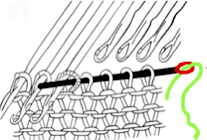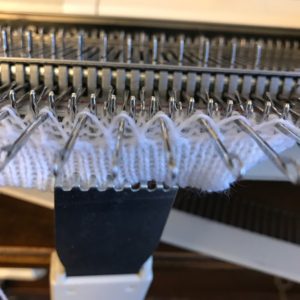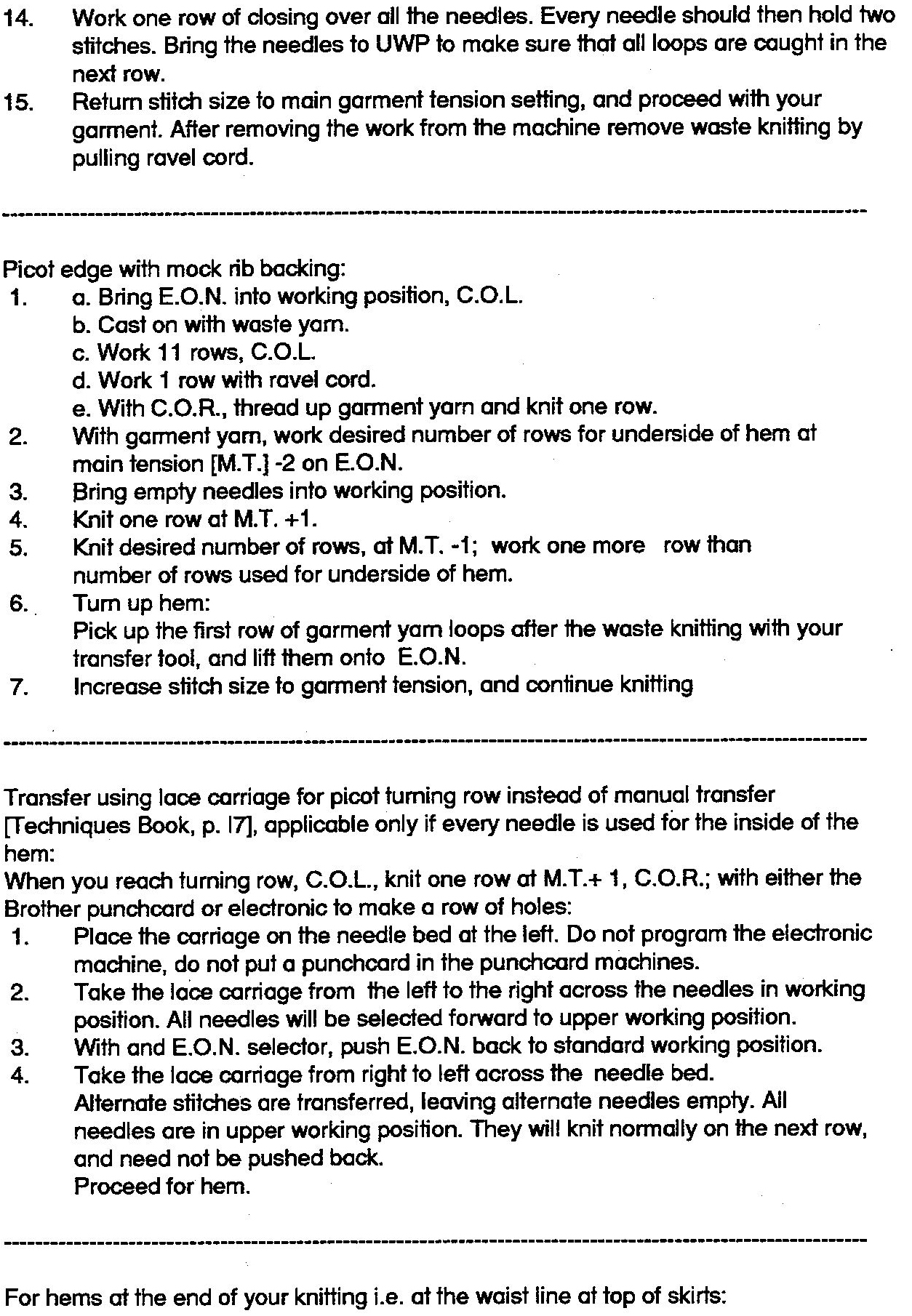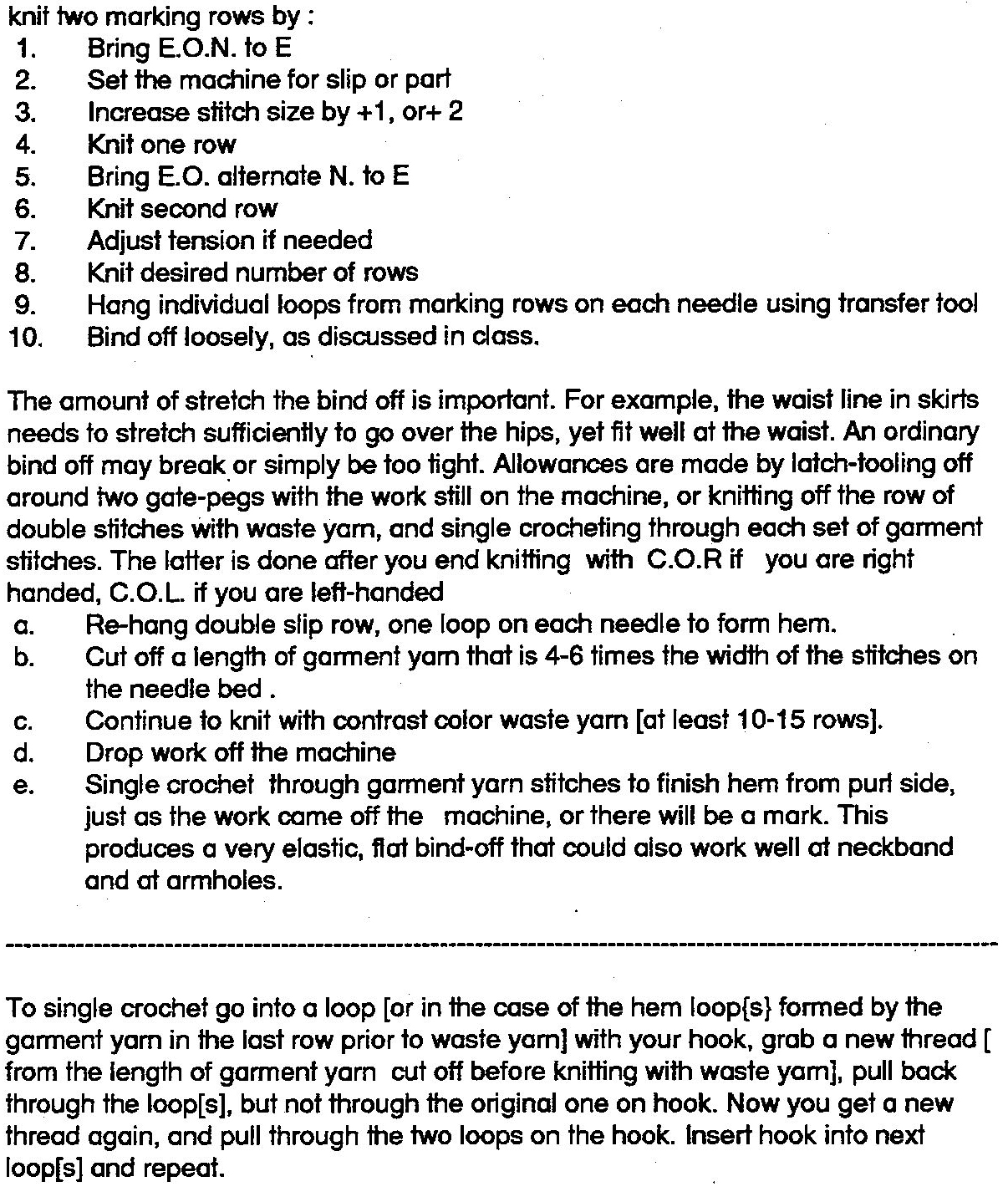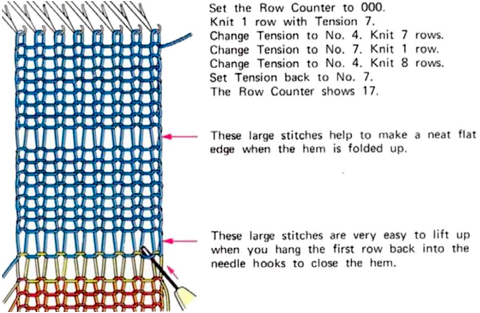Ribber trims 2 presented a series of ideas for edgings I meant to return to. Rather than adding more to that post presently, I am expanding on the topic here.
Scalloped trims are popular in single-bed knits. Preventing any needles from knitting for any number of rows will form a wave. If automatic needle selection is used, they may be formed using both the tuck and slip stitch settings.
This version from the Brother Ribber Techniques, with knitting directions included in Ribber trims and edgings 1  If there is a problem in double bed versions using loops formed by holding stitches or tuck patterning, try completing a tubular cast-on before starting either sequence.
If there is a problem in double bed versions using loops formed by holding stitches or tuck patterning, try completing a tubular cast-on before starting either sequence.
Using tuck stitch rows created manually way can work as a cast-on method:
Begin with a familiar yarn and tensions to form the usual zig-zag row from right to left
Set the ribber to slip in both directions
Bring every 6th needle on the top bed out to hold, and set the knit carriage to knit. 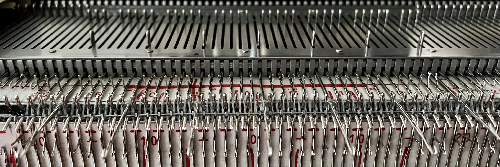 At that point the yarn will be knitting solely on the top bed, so tension needs to be adjusted closer to what may be normally used in knitting it in stocking stitch.
At that point the yarn will be knitting solely on the top bed, so tension needs to be adjusted closer to what may be normally used in knitting it in stocking stitch.
Set the ribber to slip in both directions.
Make at least 4 passes on the main bed, 6 will yield more of an effect but may be hard to manage on Japanese machines while in Passap, the strippers facilitate the process.
My first swatches were knit using 2/8 wool, which pushes the limits for smooth knitting in every needle rib on the 4.5mm machine. After knitting 5 rows the top bed stitches began riding up.  The next row needs to be knit across both beds, sealing the scallop.
The next row needs to be knit across both beds, sealing the scallop.
Bringing the top bed needles all the way forward can help with that, but to ensure gathered loops will knit off properly, a bit of fiddling may be required, any tool can be used to push down lightly on alternating sides of the loops to keep the stitches to their side from unraveling. 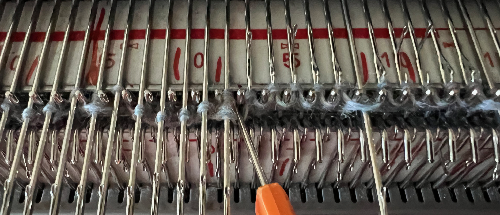 Release the hold lever on the top bed, set the ribber to knit in both directions, and continue in every needle rib to the desired length
Release the hold lever on the top bed, set the ribber to knit in both directions, and continue in every needle rib to the desired length
The top images show the result of forgetting to set the ribber to knit, so there are 2 extra all-knit rows on the top bed, the bottom images were knit with the proper setting transition 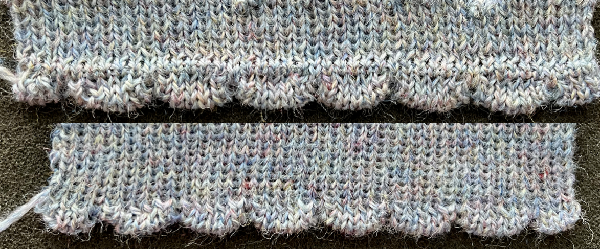 Since the top bed only knits for several rows, the ribber stitches can be seen elongated on this side of the knit
Since the top bed only knits for several rows, the ribber stitches can be seen elongated on this side of the knit  Switching to a 2/20 wool, the same needle spacing, and holding stitches for 6 rows:
Switching to a 2/20 wool, the same needle spacing, and holding stitches for 6 rows:  One last fiber switch, a different 2/20 wool shade.
One last fiber switch, a different 2/20 wool shade.
Here the detail is used at the bottom of the stocking stitch swatch rather than a ribbed one.
Watch for loops hung up on gatepegs, seen below in the top swatch.
The scallop shape wanted to turn toward the knit side but did set with some steaming.
Upon completing the holding sequence, transfer all ribber stitches to the top bed.
The tension in the swatch remained the same throughout, but in the bottom views, a loose joining row (perhaps too loose) was knit after transferring all ribber stitches to the top bed, as is often done for smoother transitions in single-bed hems. After the single loosely knit row, the tension is adjusted set to a number appropriate for the specific yarn in single-bed work.  This information and pngs expand on the knit charts in the 2019 post. If the pngs are copied, check that mode has not been altered to RGB automatically, and index back to BW mode prior to downloading them to machines for knitting.
This information and pngs expand on the knit charts in the 2019 post. If the pngs are copied, check that mode has not been altered to RGB automatically, and index back to BW mode prior to downloading them to machines for knitting.
Though, in general, starting side does not often matter, when testing techniques consistently beginning on the same side and leaving a yarn end will help identify which surface is knit facing or purl facing and whether that is of implications in the specific design.
Designing the repeat tiled for the width of the bed when working on electronic machines allows one the opportunity to add all knit borders in specific widths and to program the result as single motifs without concerns about needle placements on the knit bed or how to influence edges.
Punchcard knitters are faced with fixed 24-stitch locations on the needle bed, all knit borders would require manually bringing the needles involved out to E before each carriage pass.
As always, white pixels/unpunched areas tuck, and black pixels/ punched holes knit.
These repeats can make for interesting all-over fabrics as well as serve for edgings that flair and form bottoms that are wavy to different degrees.
12X18![]()
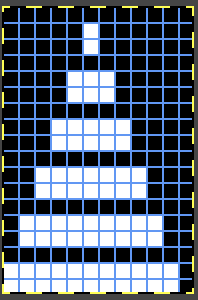 Knit using a superfine 2/18 merino: the tension on either or both beds may need to be adjusted repeatedly for stitches to form and knit off properly, reflected in stitch size variations here.
Knit using a superfine 2/18 merino: the tension on either or both beds may need to be adjusted repeatedly for stitches to form and knit off properly, reflected in stitch size variations here. 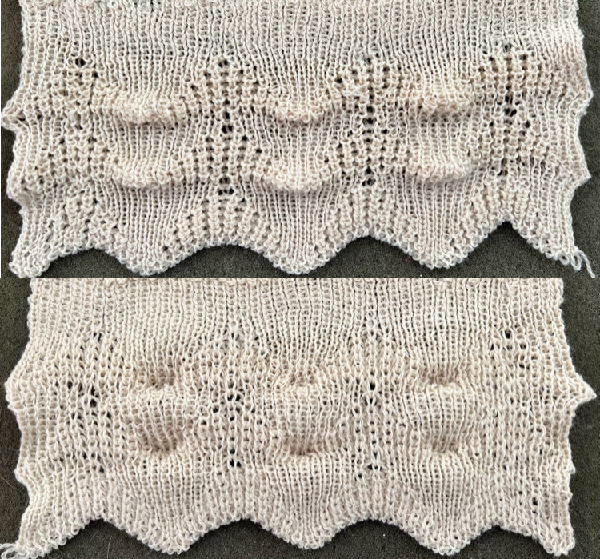 What happens when one is so engrossed with watching stitch formation that the fact that the cone has just run out of yarn is completely missed
What happens when one is so engrossed with watching stitch formation that the fact that the cone has just run out of yarn is completely missed 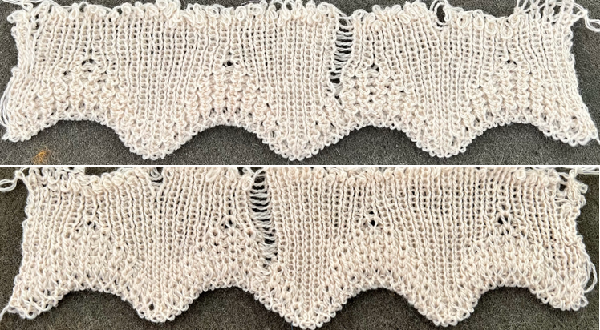 12X24
12X24 ![]()
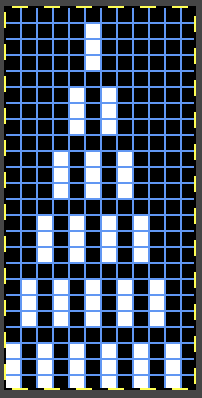 Switching yarn to 2/18 silk wool at the same tension produces knit with a very different density and drape. Light bounces off this yarn interestingly, making it harder to photograph in sharper focus.
Switching yarn to 2/18 silk wool at the same tension produces knit with a very different density and drape. Light bounces off this yarn interestingly, making it harder to photograph in sharper focus. 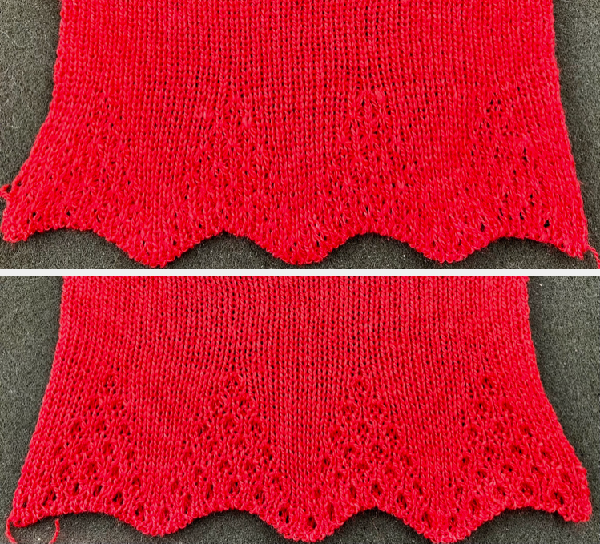 Here the same brand and weight yarn, steamed and pressed lightly, resulting in some flattening of the tuck texture’s 3D effect. Different colors or even different dye-lots of the same color in any yarn can behave differently with all else being equal. The relaxed and stretched view
Here the same brand and weight yarn, steamed and pressed lightly, resulting in some flattening of the tuck texture’s 3D effect. Different colors or even different dye-lots of the same color in any yarn can behave differently with all else being equal. The relaxed and stretched view 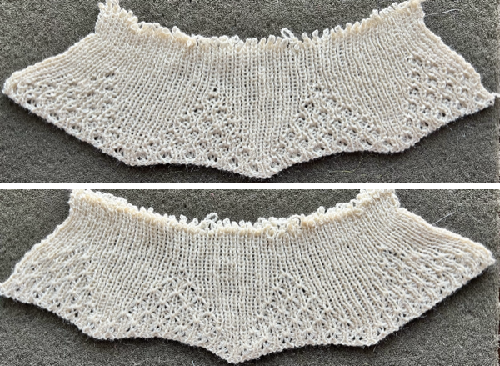 and an attempt at showing its ruffling effect.
and an attempt at showing its ruffling effect.  A very interesting surprise: a few years ago during one of my temporary obsessions I developed racked scale-like 3D patterns, this series reflects some of my first attempts
A very interesting surprise: a few years ago during one of my temporary obsessions I developed racked scale-like 3D patterns, this series reflects some of my first attempts  One of several illustrated repeats designed for assistance from needle patterning preselections
One of several illustrated repeats designed for assistance from needle patterning preselections 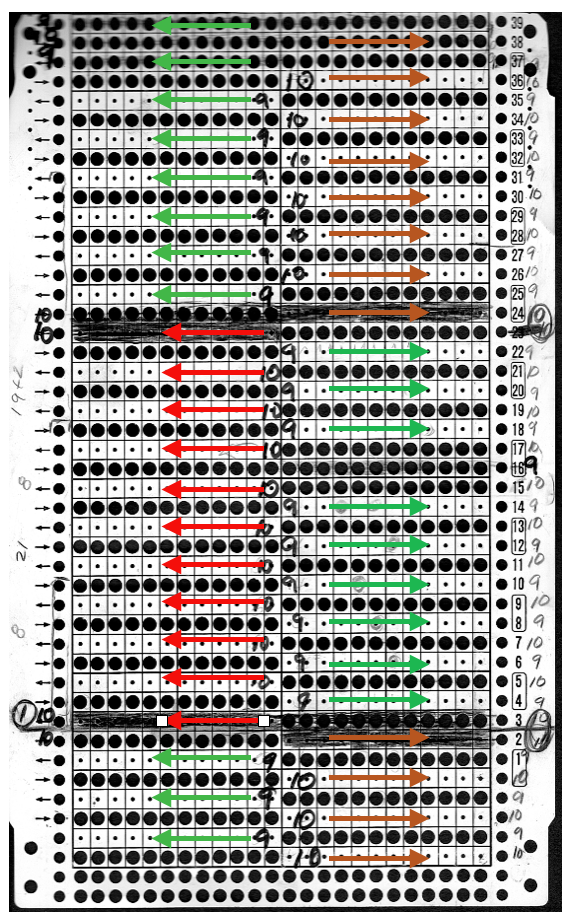 I wondered whether the triangular repeat for the trim above modified to a diamond shape might produce similar results. The proof of concept swatch was far easier to knit, with no racking, and no critical tracking of all-knit row locations than the every needle rib version.
I wondered whether the triangular repeat for the trim above modified to a diamond shape might produce similar results. The proof of concept swatch was far easier to knit, with no racking, and no critical tracking of all-knit row locations than the every needle rib version.![]()

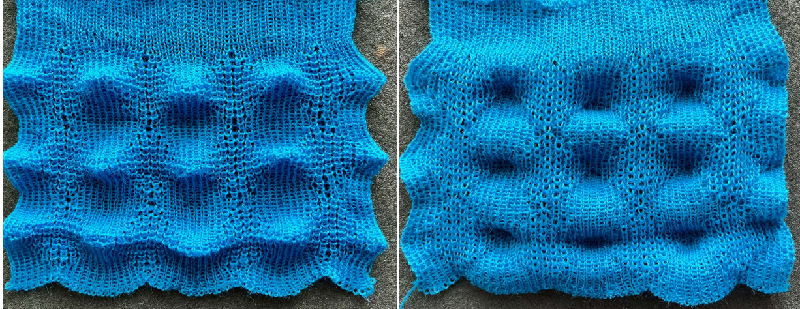
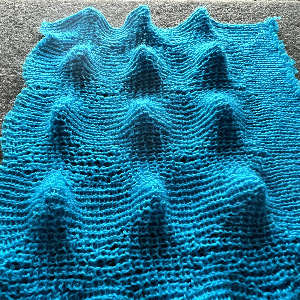 12X24, rendered suitable for punchcard use
12X24, rendered suitable for punchcard use ![]()
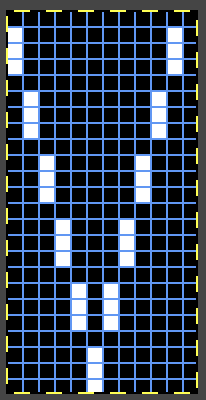 The tiled repeat for a sense of resulting pattern movement
The tiled repeat for a sense of resulting pattern movement  10X24 is missing the single all-knit vertical column seen above
10X24 is missing the single all-knit vertical column seen above ![]()
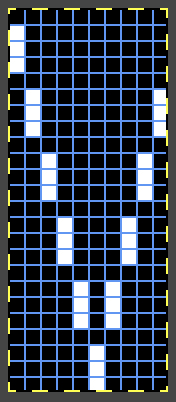 also tiled for visualizing the pattern’s movement
also tiled for visualizing the pattern’s movement 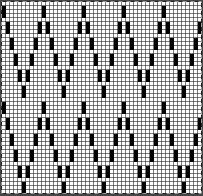 12X12 knit using the tuck setting,
12X12 knit using the tuck setting, ![]()
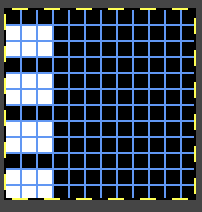
 or the slip stitch setting, making for more subtle results
or the slip stitch setting, making for more subtle results 
Category: Hems
adding hems to knit projects
Pintucks 1 vs shadow pleats
Pintucks are in the family of ripple stitches. The size of both is limited by the number of rows that may be knitted before the stitches on the bed creating the ripples begin to ride up and off the needles. The number of rows possible for the rolls varies with the model knitting machine used and the type of yarn. The Passap strippers make their knitting easier. Generally, extra weight is required.
Basic pintucks are formed across the width of the fabric, no punchcard selection is required. For some basic instructions on forming them in a single color see the blog post on Shadow pleats knitting. Its follow-up, Shadow pleats with added patterning made me curious about the possibility of creating 2 colors, FI patterned pintucks.
For a very brief period of time, some designs were published creating similar effects by hooking up elongated fair isle patterns at regular intervals on the knitting bed. The preselection for the next row knit in Brother machines poses interesting issues in restoring and maintaining the proper pattern throughout the design.
A lot of changing cam button settings can make many fabrics almost possible but not practical on home knitting machines. Some of the constant switchings of functions may be achieved by knitting with separate pairs of carriages selecting the pattern, which in electronic models advances every row, making this an electronic “special”.
Ribber fabrics produced with 2 knit carriages selecting needles introduced the idea of using a KC with a modified sinker plate to make some fabrics easier and includes a knit sample of patterned ripple fabric.
The goal here is to try to create rolls evocative of the shadow pleated swatches in a double knit.
Because of the rolling on the knit surface, designs should be lengthed at least X2. The initial test used the same pattern as that in the shadow pleated samples with the number 4, double-length key selected on the 930. ![]() The carriage setups
The carriage setups  The width of the fabric is limited. Though the KC on the right may be moved off the machine if needed, the coupled carriages cannot be since the ribber and KC used on the left do not lock together in any way, and with the stops removed the ribber carriage could conceivably slip completely off its bed. The end of the belt still needs to be cleared, but this is about as far as one can safely move, with the KC just clear of the set mark on the left of the top bed.
The width of the fabric is limited. Though the KC on the right may be moved off the machine if needed, the coupled carriages cannot be since the ribber and KC used on the left do not lock together in any way, and with the stops removed the ribber carriage could conceivably slip completely off its bed. The end of the belt still needs to be cleared, but this is about as far as one can safely move, with the KC just clear of the set mark on the left of the top bed. 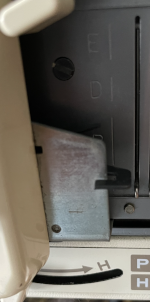 End needle selection is used in both knit carriages.
End needle selection is used in both knit carriages.
Extension rails are required.
The coupled carriages although selecting needles will be knitting on both beds to begin and end the fabric and to seal the folds setting the pleats.
To begin, test the tolerance for the number of rows knit on the top bed only. It is possible to coax extra rows by pushing fabric down between the beds by inserting a thin knitting needle between the beds at the start of the pintuck or halfway through and weighing each end. Longer rolls and hems tend to flatten.
The main bed will be knitting on every needle and FI is essentially a slip stitch, so the tension needs to be at least that for the yarns used in single bed knitting. More pronounced rolls may be produced if the tension and stitch size are adjusted accordingly.
Normally the sealing row would be knit in the light FI color. In these samples, the yellow yarn is used to help assess how those knit rows interact with the folds and to what degree they are visible.
The first try:
1. tested a solid color 8-row pintuck a single time, then switched to 6-row sequences and continued. Even though a contrasting color is used to seal the tucks, it is not immediately visible
2. the second carriage is set to FI and begins to operate from the right. Out of habit, I knit with weaving brushed down, a bad idea in this instance
3-4. this fair isle design is used double-length and forms some very long floats repeatedly, not the best choice even for single bed FI, definitely problematic here, time to regroup.
 Comparing the surface to the shadow pleat fabric
Comparing the surface to the shadow pleat fabric  For a different execution of the same design using a different main color on a different knitting day, see the bottom of the post.
For a different execution of the same design using a different main color on a different knitting day, see the bottom of the post.
Moving on to a simpler, random, smaller, 12X10 repeat ![]() planned for knitting on a 33 stitch swatch and rendered double-height planning six-row pintucks,
planned for knitting on a 33 stitch swatch and rendered double-height planning six-row pintucks, ![]() Visualizing the possible design along with placement of sealing rows represented by all-white pixel rows in the diagram. The single 8-row fold advances the remaining pattern by 2 rows, resulting in a subtle change in the design:
Visualizing the possible design along with placement of sealing rows represented by all-white pixel rows in the diagram. The single 8-row fold advances the remaining pattern by 2 rows, resulting in a subtle change in the design:  My swatch used white for the ground as in the above right, the 8-row transition is marked by the red arrow.
My swatch used white for the ground as in the above right, the 8-row transition is marked by the red arrow. 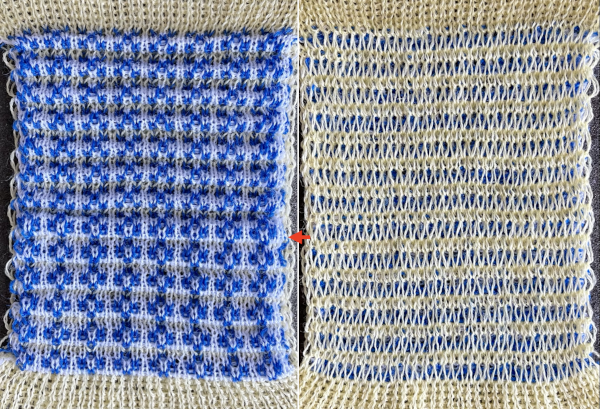 Knitting was easy and smooth, the 8-row tuck required a bit of coaxing. The fabric lies flat, does not have the drape of the single bed shadow pleats, it is not suitable for the same end-use.
Knitting was easy and smooth, the 8-row tuck required a bit of coaxing. The fabric lies flat, does not have the drape of the single bed shadow pleats, it is not suitable for the same end-use.
Plain every needle rib knit is quite a bit wider, a consideration for casting on and binding off or transitioning to another fabric if this technique is used as part of a different fabric. This file was also downloaded and lengthened X2 ![]() The pattern is not very pronounced, but the short floats make for easy knitting.
The pattern is not very pronounced, but the short floats make for easy knitting.  Comparing the fabric to the single bed shadow pleat using the same design
Comparing the fabric to the single bed shadow pleat using the same design 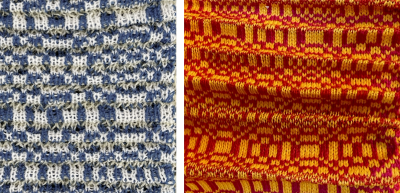 The pintuck main bed FI yarn could be slightly thicker. Since the 6-row sequence appears to work well, if the fabric is to be pursued, the design could be planned and adjusted accordingly.
The pintuck main bed FI yarn could be slightly thicker. Since the 6-row sequence appears to work well, if the fabric is to be pursued, the design could be planned and adjusted accordingly.
Issues encountered in DIY deliberate design planning: beginning in Numbers, a table is set up with enough rows to accommodate more than the height of the planned design. Since the fabric planned would knit 6 rows on the top bed, then followed by 2 rows on both beds not affecting the design, starting at the bottom of the table, use the command key and work on hiding 2 rows following groups of 6 for the height of the table 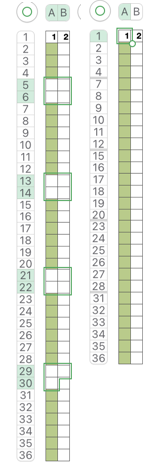 The theoretical design in beginning stages:
The theoretical design in beginning stages:
1: the rows marked in green are hidden
2. a design is drawn using 2-row blocks and shaping
3: it is tiled, appears worth pursuing.
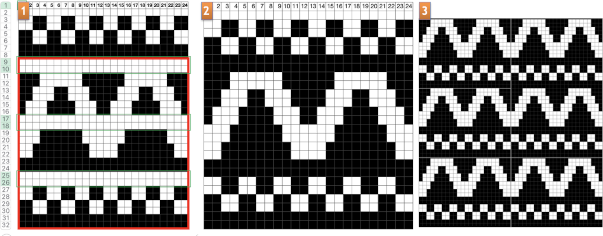 The expected carriage actions, color reversing the repeat so that the dark color will knit in feeder A of the FI single bed sinker plate
The expected carriage actions, color reversing the repeat so that the dark color will knit in feeder A of the FI single bed sinker plate  Points to consider while removing the use of the ribber from the equation:
Points to consider while removing the use of the ribber from the equation:
both knit carriages are set for the end needles to select. When knitting fair isle this is necessary to keep the contrast color knitting from separating from the base color along the design edge. If at any point there are single-color stripes, the end needles if selected need to be pushed back to the B position, or the second color will catch the first and last needles in work, forming a float from side to side. If the yarn is removed from the B feeder and end needles are not pushed back to B, stitches on them will drop. My first try ![]() The transition to color reverse shown tiled
The transition to color reverse shown tiled  Leaving the contrast color in the B feeder on the all knit black pixel rows created the first mess. Because of preselection, the return to knit dark rows has every needle coming forward as the single bed KC is traveling back to the right, resulting in another mess.
Leaving the contrast color in the B feeder on the all knit black pixel rows created the first mess. Because of preselection, the return to knit dark rows has every needle coming forward as the single bed KC is traveling back to the right, resulting in another mess.
Regrouping so the first pair of rows with no preselection will knit the dark color, the second pair of rows with no preselection will knit using the paired carriages, sealing the fabric, the larger geometric shape has 2 rows with no needle selection nearly at its halfway point. 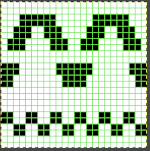
![]() The broken threads are due to stitches getting hung up on gate pegs, missed until more knitting had been completed. With more attention, knitting went more smoothly, and the planned design is identifiable.
The broken threads are due to stitches getting hung up on gate pegs, missed until more knitting had been completed. With more attention, knitting went more smoothly, and the planned design is identifiable.  Perhaps as a farewell to the topic or out of sheer stubbornness now that the above had been knit and I have had some practice, I returned to the more straightforward knitting of that double-length flower pattern with far improved results. Some of the floats trapped behind the long stitches created on the ribber can be seen bleeding through on the right.
Perhaps as a farewell to the topic or out of sheer stubbornness now that the above had been knit and I have had some practice, I returned to the more straightforward knitting of that double-length flower pattern with far improved results. Some of the floats trapped behind the long stitches created on the ribber can be seen bleeding through on the right. 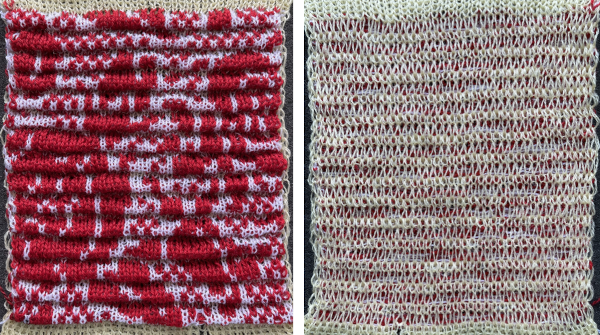 Comparing the scale once again to the shadow pleats
Comparing the scale once again to the shadow pleats  This fabric may fall in the category that need not be knit simply because one can. That said it may serve well in bands joined onto larger pieces, or any use for it may only be limited by patience and imagination.
This fabric may fall in the category that need not be knit simply because one can. That said it may serve well in bands joined onto larger pieces, or any use for it may only be limited by patience and imagination.
Revisiting pleats on the knitting machine: single bed
A cumulative collection of links to pleat-related blog posts
Single bed
Origami folds inspired pleats 1
Shadow pleats with added FI patterning
Shadow pleats knitting
Revisiting pleats on the knitting machine: single bed
Pleats created with lace transfers
Ruching 2: more working with stitch groups
Ruching 1: fern “pretender” and more
Pleats: automating “pleating”, single bed
Double bed
Pintucks 2, ripples in knits using the ribber
Pintucks 1 vs shadow pleats, Fair Isle pintucks
Origami-inspired 2: more pleats and fold using ribber
Slip stitch patterns with hand-transferred stitches, double bed
Knit and purl blocks to create folding fabric_ “pleats”
Pleats: ribbed, folding fabrics
On two needles hand-knit and purl folds
Some authors and publications include hems in the category of pleats as “horizontal”. To my mind, they merit their own category.
HEMS
Machine knit hems 2
Machine knit hems 1
Ruching/hooked-up stitches
Any techniques may also be used on only parts of finished projects.
Presently, in fashion and knitwear, skirts and clothing with ruffled or folded fabric variations abound.
In 2013 I shared a post on automating single bed pleats including downloadable files of one of my early handouts and working notes.
This post contains some of the same information, repeated for convenience, along with additional info and images added in 2023.
Addition: transfer lace punchcard repeats for Brother machines can vary, from 6 stitch patterns to 8, 12, and 24. Two blank rows (grey cells) would be added above the transfer marks (black dots) below to complete a single transfer repeat. The red line marks the centerline of the 24 stitches. 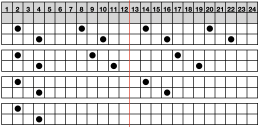


 Proof of concept swatches:
Proof of concept swatches:
a slip stitch design repeat, punchcard-suitable, is redrawn with black dots representing knit stitches, and blank cells representing slipped/skipped ones. Empty circles along with red numbers mark the locations where stitches are transferred to the right or left, and empty needles are pushed back to A position, out of work/OOW, resulting in ladders.  The appearance of the knit side,
The appearance of the knit side, 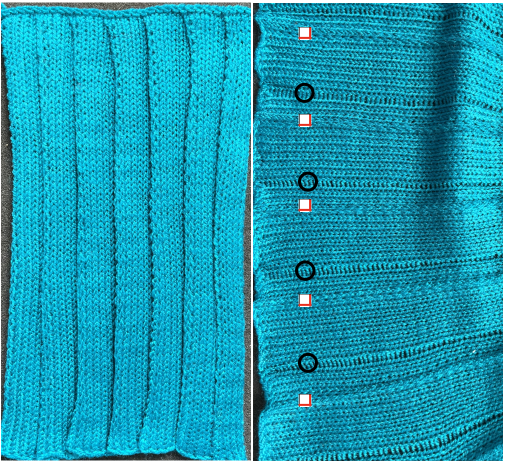 and the purl
and the purl  Vertical lace transfers:
Vertical lace transfers: 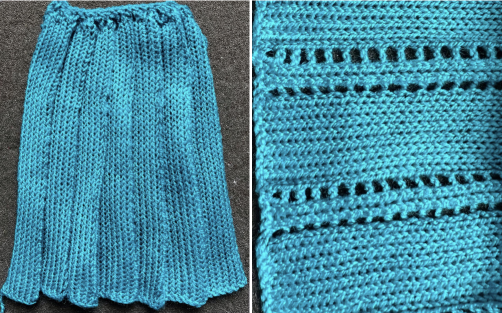
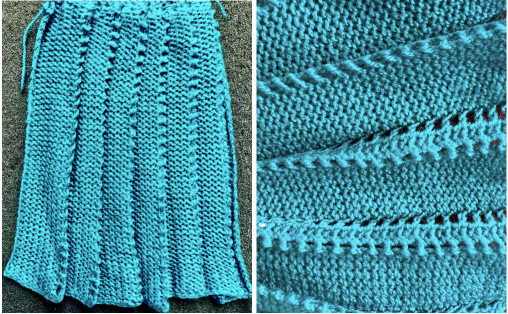 When working in a stocking stitch, if a soft-looking pleat is desired, the knitted fabric is simply folded to form the pleat and joined to keep the fold. Crisper folds require the added techniques described above. In hand-knitting fold lines are created by slipping stitches on the fold line on the “public side”. Assuming the latter is the knit side of the fabric, this is often indicated by “sl1 with yarn in the back” for the front fold line (and as another slip stitch option, with yarn in front for the back fold line). A purl stitch is more commonly worked on the same side of the knit for the opposing, inner fold. Both the slipped stitch and the purl one are purled on the return purl row pass. It is also possible to work the former purl stitch as a purl, resulting in a garter stitch inner fold.
When working in a stocking stitch, if a soft-looking pleat is desired, the knitted fabric is simply folded to form the pleat and joined to keep the fold. Crisper folds require the added techniques described above. In hand-knitting fold lines are created by slipping stitches on the fold line on the “public side”. Assuming the latter is the knit side of the fabric, this is often indicated by “sl1 with yarn in the back” for the front fold line (and as another slip stitch option, with yarn in front for the back fold line). A purl stitch is more commonly worked on the same side of the knit for the opposing, inner fold. Both the slipped stitch and the purl one are purled on the return purl row pass. It is also possible to work the former purl stitch as a purl, resulting in a garter stitch inner fold.
To review, parts of pleats:
knife pleats may be put next to each other and pointing to the right (S)  or the left (Z)
or the left (Z)
Box pleats are composed of alternating right and left knife pleats, pointing away from each other. Inverted box pleats are composed of one left and one right knife pleat, pointing toward each other.
 Accordion pleas are a series of knife pleats in which the back of one pleat forms the face of the next
Accordion pleas are a series of knife pleats in which the back of one pleat forms the face of the next 
It is possible to knit folding pleats in a knitted stocking stitch with the pleats formed vertically rather than sideways. The two needles (highlighted in red) close together form the top hard outer ridge, and the two empty spaces where needles are out of work (red dots) form the under-fold. The remaining black dots represent out-of-work needles as well  Normally, EON knitting is reserved for tuck lace or heavier yarns on standard machines. For my test swatch, I used a coarse 2/8 wool on tension 4
Normally, EON knitting is reserved for tuck lace or heavier yarns on standard machines. For my test swatch, I used a coarse 2/8 wool on tension 4

 The fabric narrows considerably as it is stretched lengthwise to set the stitches. Several panels would be required for a garment such as a skirt. Such an item would need to be pulled into shape, pinned, and hot pressed. Fiber content will determine the crispness of the pleats after blocking, and their retention after cleaning. The swatch below is turned sideways for the sake of space.
The fabric narrows considerably as it is stretched lengthwise to set the stitches. Several panels would be required for a garment such as a skirt. Such an item would need to be pulled into shape, pinned, and hot pressed. Fiber content will determine the crispness of the pleats after blocking, and their retention after cleaning. The swatch below is turned sideways for the sake of space. 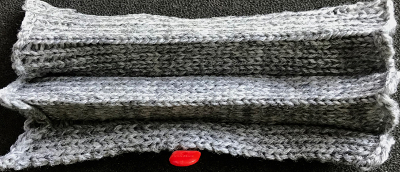 More variations with folds can be made by varying the “rules” commonly recognized for creases. Working sideways once more: on a punchcard machine, using card # 1 locked, cast on making certain every other needle as well as the first and last are selected.
More variations with folds can be made by varying the “rules” commonly recognized for creases. Working sideways once more: on a punchcard machine, using card # 1 locked, cast on making certain every other needle as well as the first and last are selected.
In the swatch varies the number of all knit rows between creasing methods. Overlapping at fixed width at the top of the piece once the fabric is rotated lengthwise, creates a fair amount of bulk as pleats are fixed.
The all-knit sections could be combined with holding techniques to vary the width of pleats from one end to a different width than at the other.
The change knob remains set to KC throughout.
With no cam buttons selected, all stitches will knit.
After the desired number of rows, cam buttons are set to slip in both directions for at least 4 rows (commonly this is done for 2).  Cancel the slip setting, complete the next knit section, and transfer every other needle to the adjacent one on either the right or left.
Cancel the slip setting, complete the next knit section, and transfer every other needle to the adjacent one on either the right or left. 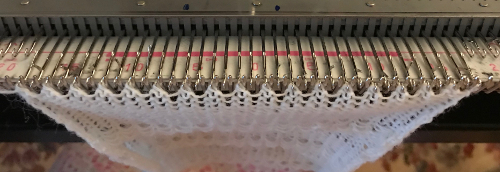 The needles holding 2 stitches may be brought out to the hold position as each transfer is made, or pushed out to hold after the fact to insure the stitches have been transferred and will knit off properly. The number of needles in work remains constant.
The needles holding 2 stitches may be brought out to the hold position as each transfer is made, or pushed out to hold after the fact to insure the stitches have been transferred and will knit off properly. The number of needles in work remains constant.  Change the cam buttons to tuck in both directions. On the first carriage pass, the empty needles will pick up a loop, on the second pass a second loop will be formed on those same needles.
Change the cam buttons to tuck in both directions. On the first carriage pass, the empty needles will pick up a loop, on the second pass a second loop will be formed on those same needles.  Cancel the tuck setting, and leave the needle selection on to form knit stitches once again, continue with the determined number of rows.
Cancel the tuck setting, and leave the needle selection on to form knit stitches once again, continue with the determined number of rows.
Repeat the process beginning with the slip stitch setting once more.
The yarn used is a 2/24 acrylic, seen here stretched flat. 
 The slipped stitches form the inside folds in the pressed swatch, while eyelets and tuck stitches fold a picot edge to the outside.
The slipped stitches form the inside folds in the pressed swatch, while eyelets and tuck stitches fold a picot edge to the outside. 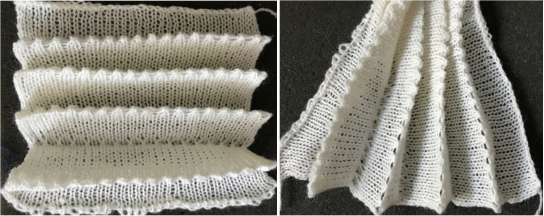 The placement of the holding sequences may be varied, with the eyelets allowed to form and considered a potential design feature.
The placement of the holding sequences may be varied, with the eyelets allowed to form and considered a potential design feature.  The number of slip floats or tucked stitches may also be altered by widening the slip repeat or lengthening it, and tucking on alternate pairs of stitches for usually no more than two rows.
The number of slip floats or tucked stitches may also be altered by widening the slip repeat or lengthening it, and tucking on alternate pairs of stitches for usually no more than two rows.  Extending the repeat to a punch card with slipped or tucked stitches flanked by a single knit stitch on either side. The outlined blocks of colored cells represent subsequent knit rows.
Extending the repeat to a punch card with slipped or tucked stitches flanked by a single knit stitch on either side. The outlined blocks of colored cells represent subsequent knit rows.
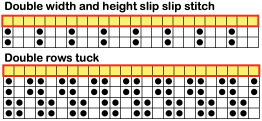 The folds to the purl side may also be created by simply doubling up the yarn for a single row. Both yarns in this case are 2/8 wool. The second color is used for illustration purposes but might be a design feature in some pieces, and is not clearly visible on the knit side.
The folds to the purl side may also be created by simply doubling up the yarn for a single row. Both yarns in this case are 2/8 wool. The second color is used for illustration purposes but might be a design feature in some pieces, and is not clearly visible on the knit side. 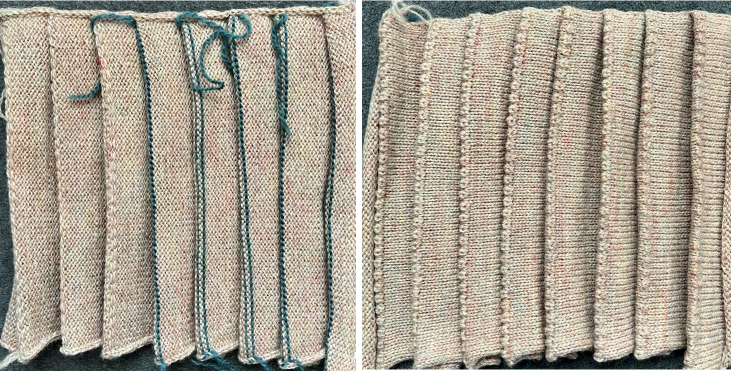
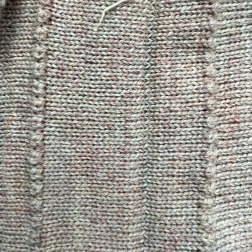 Hand selection aided by some of the standard multiple-selection tools is easy enough to use for tests on small swatches to determine resulting effects and preferences prior to any programming.
Hand selection aided by some of the standard multiple-selection tools is easy enough to use for tests on small swatches to determine resulting effects and preferences prior to any programming.
In this swatch, such increases are combined with holding techniques for what might become anything from an extended ruffle to a full skirt.
The issue with sideways knits is that the number of needles available and the knit gauge may limit the possible length of any garment produced in a single piece. 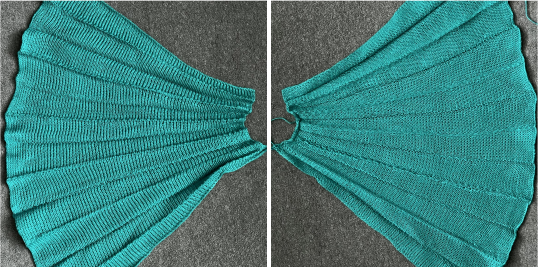 Single bed pintucks may be made by knitting any number of rows on the top bed, followed by the use of every other needle selection to create slip-stitch floats on the machine to serve as markers. The short floats are picked up and hooked onto the corresponding needles in work after more knit rows.
Single bed pintucks may be made by knitting any number of rows on the top bed, followed by the use of every other needle selection to create slip-stitch floats on the machine to serve as markers. The short floats are picked up and hooked onto the corresponding needles in work after more knit rows.
Short-row shaping may be automated to include needle wrapping to diminish the size of the resulting eyelets. 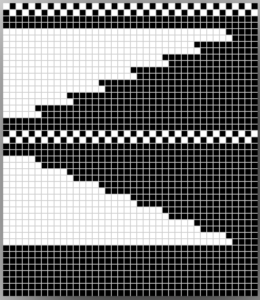 This photo is of a multiple-decades-old skirt that has been stored folded for years, as taken out of the storage box. It measures 26 inches in length, with a 97.5-inch bottom circumference. Single tuck and slipped stitches were used along with short rows to create intentionally soft folds.
This photo is of a multiple-decades-old skirt that has been stored folded for years, as taken out of the storage box. It measures 26 inches in length, with a 97.5-inch bottom circumference. Single tuck and slipped stitches were used along with short rows to create intentionally soft folds. 
Useful math calculators for planning wedges
A look at miters, spirals, and angles to create shapes
Some notes on circular shawls
Round yokes and more
Hems created using this technique are faster than those where every needle is rehung and may be stuffed or threaded with other materials ie suitable size plastic tubing, or upholstery cords for sculptural effects. 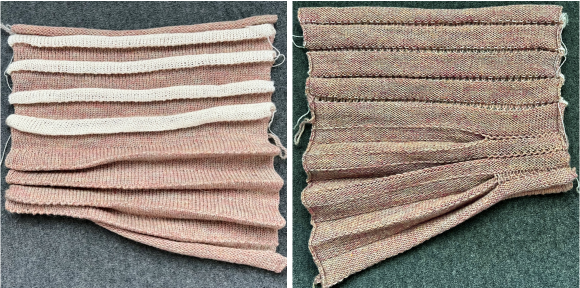
Planning is required for the best method as to how to join panels in items such as skirts.
Markers at regular counts added while the work is on the machine in areas that are to be folded or gathered into a waistband, yoke, or to other shaped pieces are useful.
Machine knit hems 2
Hems 1: previous post. Guidelines generally given for stocking stitch hems do not take into consideration if the body of the knit is going to be considerably narrower or wider than the stocking stitch, and whether the purl side of the fabric is to be used as the “public side”. In the latter case, the solution is simply to reverse tension changes from the inside to the outside of the hem. For wider or narrower fabrics the number of stitches for the hems may need to be recalculated, depending on whether a series of simple tension adjustments can solve the problem. Fiber content, yarn weight, and even color can affect results, so always test a swatch. It is possible to knit tubular hems using the ribber, but here the discussion is for the single bed only.
Hems at the beginning: cast on and knit several rows of waste yarn, ending with ravel cord. Following step 1 below: set the stitch dial one number lower than that used originally in stockinette knitting. Knit the number of rows required for the inside of the hem. Loosen tension by 2 numbers for one row (helps get a neater turning row). Tighten tension by one to the original stockinette tension, and proceed as indicated in steps 2 and 3 below. Illustrations are from Brother techniques Book, pp. 16 and 17. 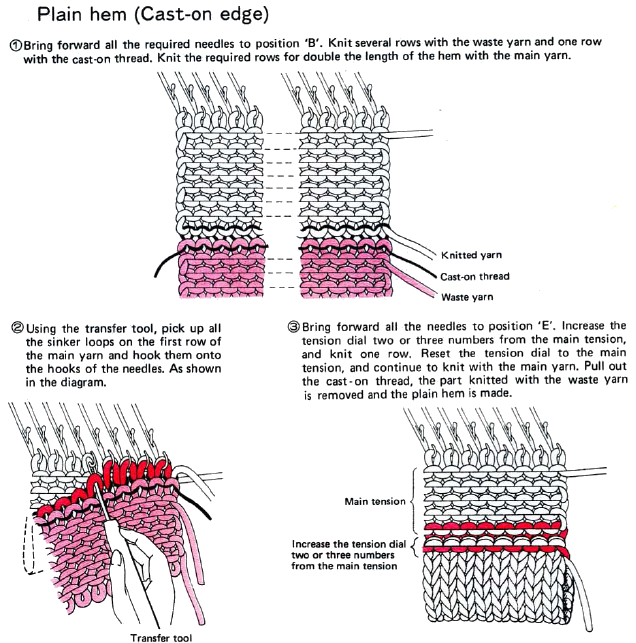
Picot hems: odd number of needles are required.
1: Cast on an odd number of stitches and knit several rows of waste knitting followed by 1 row knit with ravel cord. Set the stitch dial one full number (guideline) tighter than the main yarn and knit as many rows as required for the depth of the hem.
2: Picots are made by transferring stitches onto adjacent needles, making transfers to either left or right (shown in illustrations below).
3: Reset the stitch dial to stockinette tension and knit the same number of rows. 4: Place the sinker loops on the corresponding needles, making sure to pick up the edge sinker loop as well. Directions usually say to pull our ravel cord at this point, I like to knit a few rows and to make certain things have knit properly before removing the cord.
5: set the stitch dial 2-3 whole numbers higher than the stocking stitch tension and knit one row. This keeps the joining row from bulging out due to its double thickness.
6: Reset the tension dial to stocking stitch tension and continue to knit.
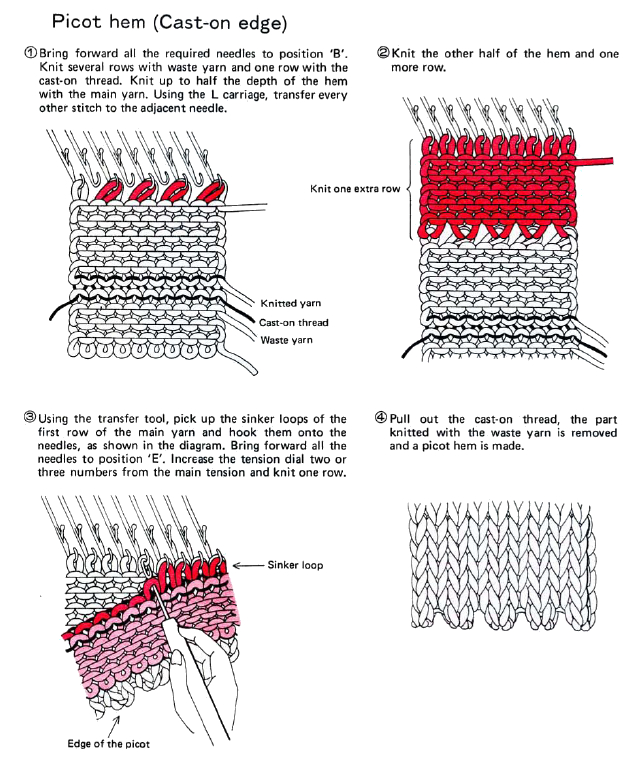 After transfers, always check that proper transfers have indeed been made and that each needle holds 2 stitches. Bringing all needles out to E before knitting the next row helps facilitate a visual check.
After transfers, always check that proper transfers have indeed been made and that each needle holds 2 stitches. Bringing all needles out to E before knitting the next row helps facilitate a visual check.
Hems with the 1X1 needle arrangement below will often require at least one more row for the outside of the hem than for the backing since the EON-produced stitches will grow in size and lengthen when the fabric is set
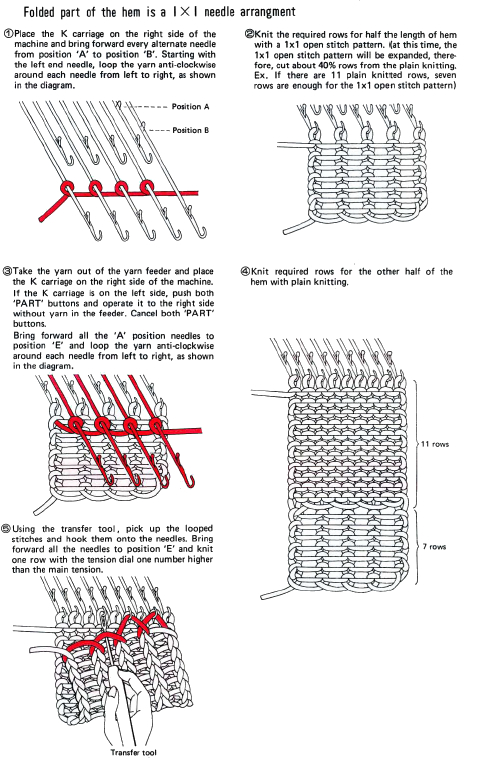 In step number 3 the e-wrapped row essentially casts on those empty needles, so that when the following row is knit, full stitches are formed on each needle, and when the hem is folded any appearance of eyelets is minimized.
In step number 3 the e-wrapped row essentially casts on those empty needles, so that when the following row is knit, full stitches are formed on each needle, and when the hem is folded any appearance of eyelets is minimized.
for illustration, the e-wrap row in a contrasting color (white is acrylic fiber) as knitting continues
as knitting continues 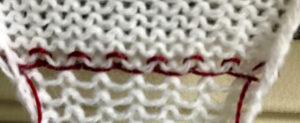 the hem exterior after some pressing
the hem exterior after some pressing  hem interior
hem interior 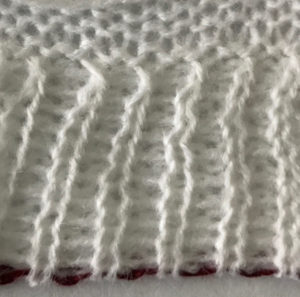
An alternate method to step 3, producing a picot at the turn of the hem: bring empty needles out to hold position, and knit across to the opposite side. With the first pass, loops will form on empty needles, with the second pass reversing direction, an eyelet is formed and full knitting is restored for the outside hem. EON knitting tends to grow in length. I prefer to reduce EON tension by at least 2 numbers. Test on a swatch to determine the percentage of total rows needed to place the picot at the hem fold rather than having it roll out to the knit side, it will vary depending on the yarn used.
For the picot hem transfers using the lace carriage: after knitting with waste yarn and ravel cord, knit half the depth of the hem. Place the Lace carriage opposite the knit carriage, on either the left or right-hand side. Starting with the second needle from either side, bring forward every other needle to the D position using the 1X1 needle pusher. End needles must be in the B position. Move the lace carriage to the opposite side, every other stitch will now be transferred onto the adjacent needle. Remove the carriage by using the release button, and continue to knit as described above.
Again, I like to knit several rows after picking up stitches and completing the hem before removing the ravel cord and waste yarn.
If you prefer not to use waste yarn, for the inside hem on every needle (method 1 from the previous post). If using the comb: e wrap EON on an odd number of needles, hang the cast-on comb with teeth pointing away from you and proceed as below. 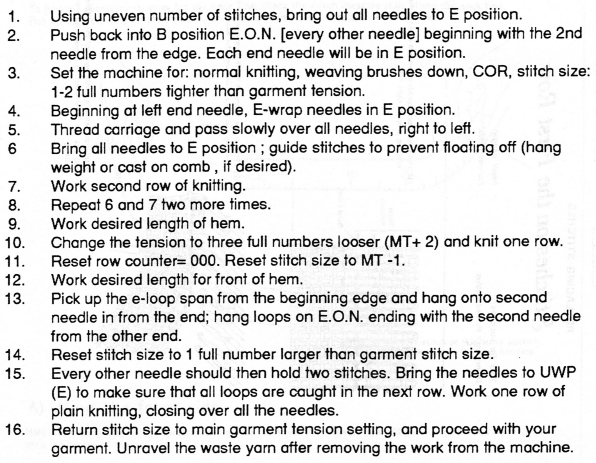 Using the cast-on comb to speed up rehanging stitches to close hem: a foreign language video showing its use on the mock rib at the top of socks. The method can be used for any configuration needle setup. It is possible to use ribber cast on combs for the same purpose, I will address that in another post. When EON loops are used to join the hem, the inside of the hem will “drop” some when set, so fewer rows are required on the inside hem.
Using the cast-on comb to speed up rehanging stitches to close hem: a foreign language video showing its use on the mock rib at the top of socks. The method can be used for any configuration needle setup. It is possible to use ribber cast on combs for the same purpose, I will address that in another post. When EON loops are used to join the hem, the inside of the hem will “drop” some when set, so fewer rows are required on the inside hem.
When hanging any hem, one stitch is lost on the side of the cut yarn end. Also, on the knot side, the stitch may be less noticeable, so you want to make certain that that outside loop/ stitch is also included in the count (green arrow)
 I like to secure the main color yarn end as seen below around the adjoining empty needle as seen below
I like to secure the main color yarn end as seen below around the adjoining empty needle as seen below
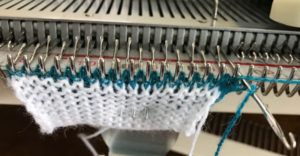 continue knitting
continue knitting 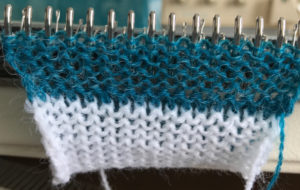 forgot ravel cord? find the outside of the last stitch knit in waste yarn, opposite yarn ends
forgot ravel cord? find the outside of the last stitch knit in waste yarn, opposite yarn ends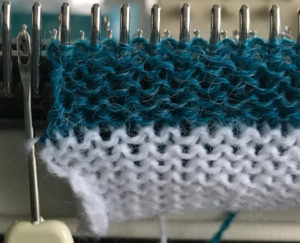 clip stitch, pull out “ravel cord”, continue knitting
clip stitch, pull out “ravel cord”, continue knitting
Note: ravel cord ideally should be smooth, nonshedding fiber, and strong enough not to break when pulled on. If like fibers are used and they shed as the cord is removed, you may have tiny fibers of the contrasting color permanently mating with your garment yarn. Check for any knots in the cord at each side of the knit before pulling it out.
Instructions for single-bed mock rib from 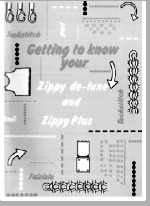
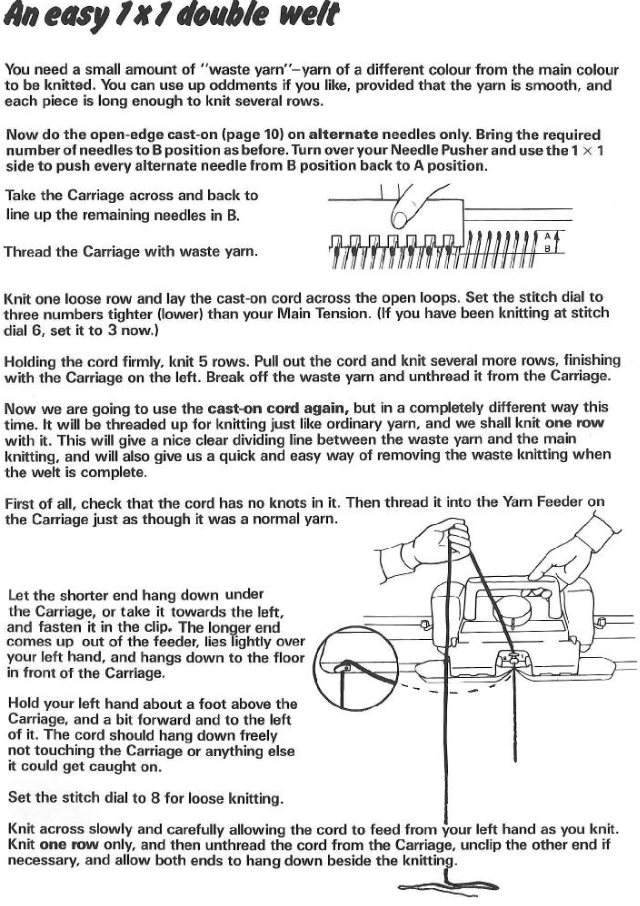
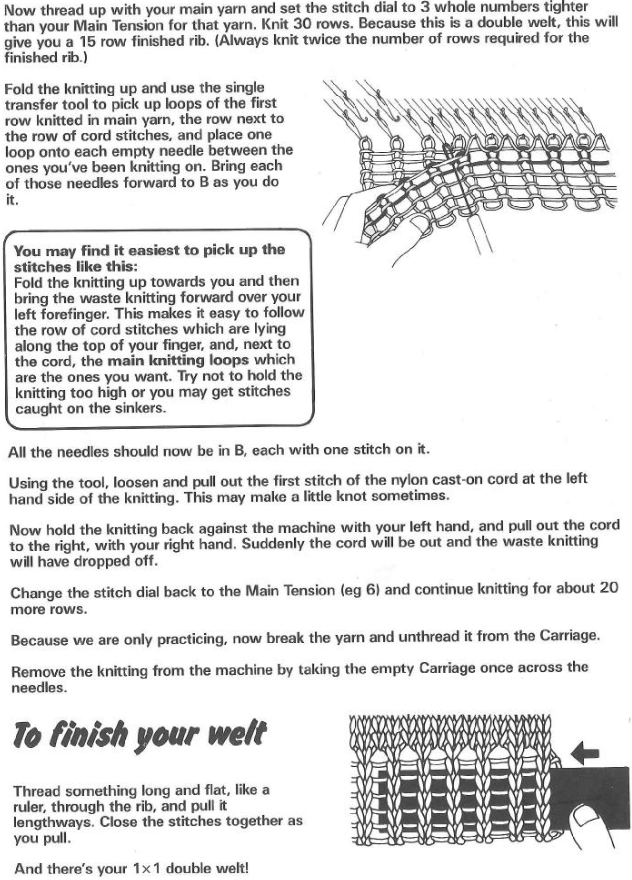
Seaming, joining, picking up stitches on knits 2
I have an extensive library of both hand and machine knitting publications. I am not the originator of the base drawings for these illustrations. However, they have been accumulated from various decades-old sources, edited by me for content, color, size, etc. My editing program is Gimp. I will review, alter, or add to this library over time.
Sewn bind-offs on the machine

 knitting taken off on waste yarn joining a hem
knitting taken off on waste yarn joining a hem 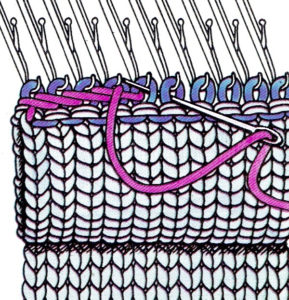 open stitches to finished hem
open stitches to finished hem  crochet bind-off through the top or bottom of stitches in the last row respectively
crochet bind-off through the top or bottom of stitches in the last row respectively  weaving in yarn ends across a row on the purl side
weaving in yarn ends across a row on the purl side  Mattress stitch: work a few rows with loose stitches so entry and exit points are visible, then pull on yarn and tug on finished segments as you go to adjust stitch size
Mattress stitch: work a few rows with loose stitches so entry and exit points are visible, then pull on yarn and tug on finished segments as you go to adjust stitch size
1. under the single bar between a full knit stitch on either edge of knitting, best for bulkier knits
2. under double bars between a full knit stitch on either edge of knitting, faster on smaller gauge knit
3. worked half a stitch away from the edge, every row, under the bar on left, loop on the right
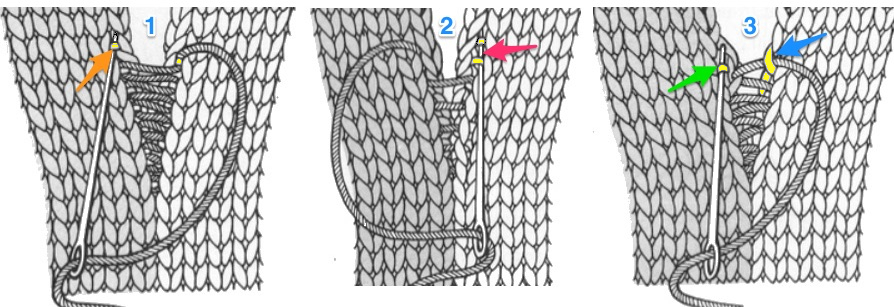 4. running stitch along and through the center of edge stitches, alternating sides every row
4. running stitch along and through the center of edge stitches, alternating sides every row
5. running stitch one full stitch away from the edge, alternating sides every row
6. joining purl stitches in every row
 garter stitch
garter stitch 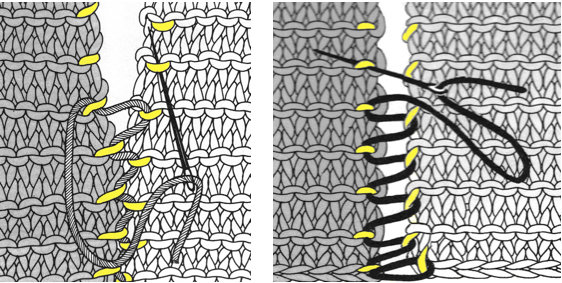 1. mattress stitch, knit side out, one full stitch away from the edge, adding a second strand of yarn to finish the join
1. mattress stitch, knit side out, one full stitch away from the edge, adding a second strand of yarn to finish the join
2. weaving in joined yarns along the inseam, traveling in opposite directions
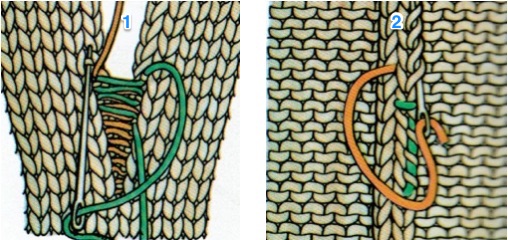 2 X 2 rib ending with one knit stitch
2 X 2 rib ending with one knit stitch 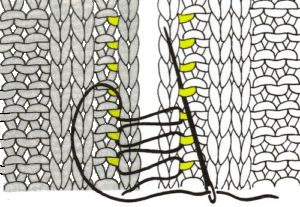 2 X 2 rib ending with 2 knit stitches
2 X 2 rib ending with 2 knit stitches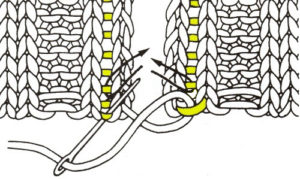 rib join through “edge loops” of knit stitches
rib join through “edge loops” of knit stitches  2 X 2 rib join ending with 2 knit stitches, 1 full stitch from edge
2 X 2 rib join ending with 2 knit stitches, 1 full stitch from edge 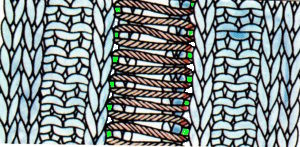 2 X 2 rib join ending with 2 purl stitches, 1 full stitch from edge
2 X 2 rib join ending with 2 purl stitches, 1 full stitch from edge 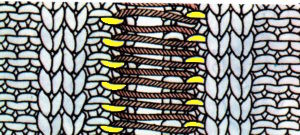 For more illustrations in addition to the above for joining ribbed stitches see the later 2022 post
For more illustrations in addition to the above for joining ribbed stitches see the later 2022 post
Picking up stitches to continue knitting or joining on the machine: straight edges,  curved edges
curved edges 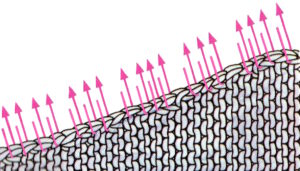 open sts to bound off; bound off sts to bound off (steps 1 and 2)
open sts to bound off; bound off sts to bound off (steps 1 and 2) knit to purl; knit to rib
knit to purl; knit to rib 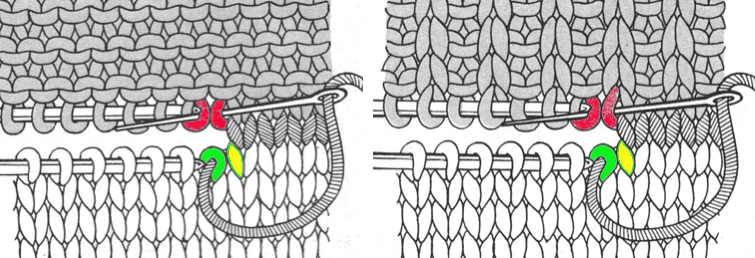 garter-stitch
garter-stitch 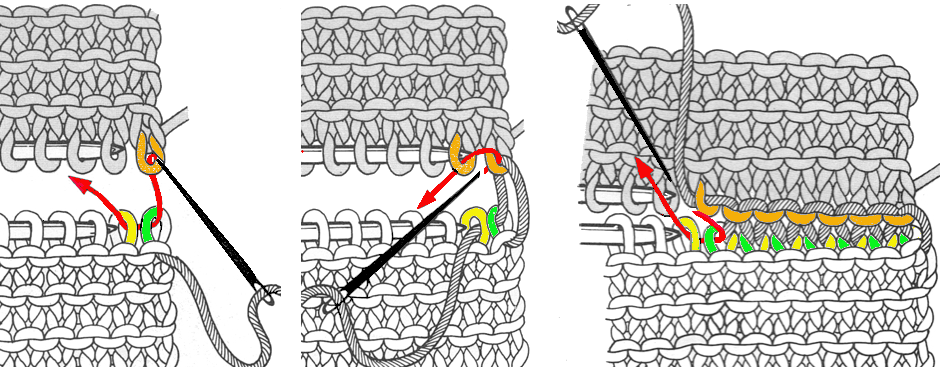 decreasing evenly at intervals across a row
decreasing evenly at intervals across a row  grafting with purl side facing
grafting with purl side facing 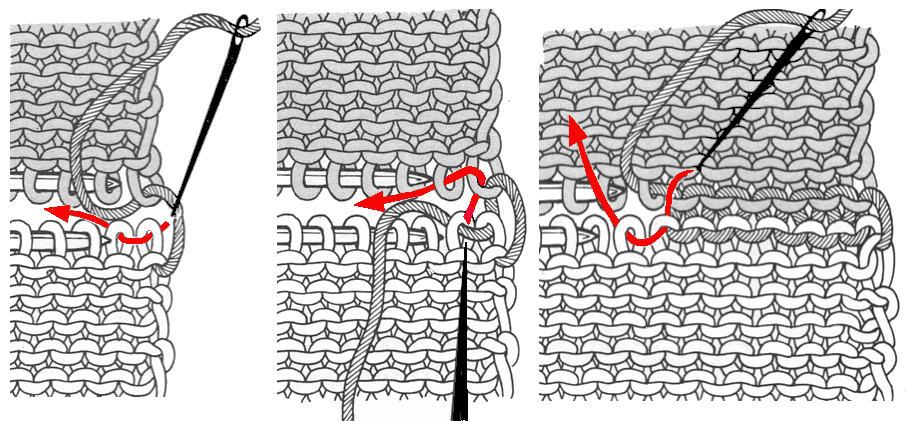 if you are left-handed or the yarn end is on the alternate piece, rotating the image or flipping it horizontally or vertically will provide guidelines.
if you are left-handed or the yarn end is on the alternate piece, rotating the image or flipping it horizontally or vertically will provide guidelines.  There are many alternatives for increasing and decreasing stitches. These pages are from the KH 800, a Brother model made in 1970-71, and cover the basics and the often underused technique of using a knitting needle to remove stitches from the machine for any reason, here intended for decreasing evenly across a row as an alternative to scrapping off on waste yarn or using a garter bar.
There are many alternatives for increasing and decreasing stitches. These pages are from the KH 800, a Brother model made in 1970-71, and cover the basics and the often underused technique of using a knitting needle to remove stitches from the machine for any reason, here intended for decreasing evenly across a row as an alternative to scrapping off on waste yarn or using a garter bar.
Long and thin double-pointed needles are best on the standard, and sizing is more flexible when working on the bulky. If a double-pointed one is used, have a needle stopper on one end, and swap it out to the opposite side when shifting stitch positions. The work could be turned over with this technique as well.
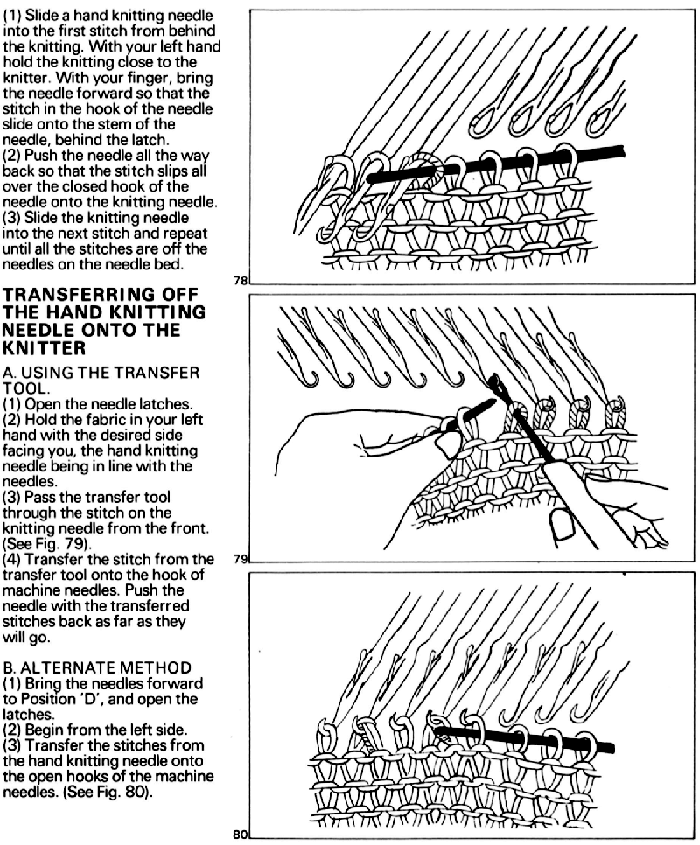
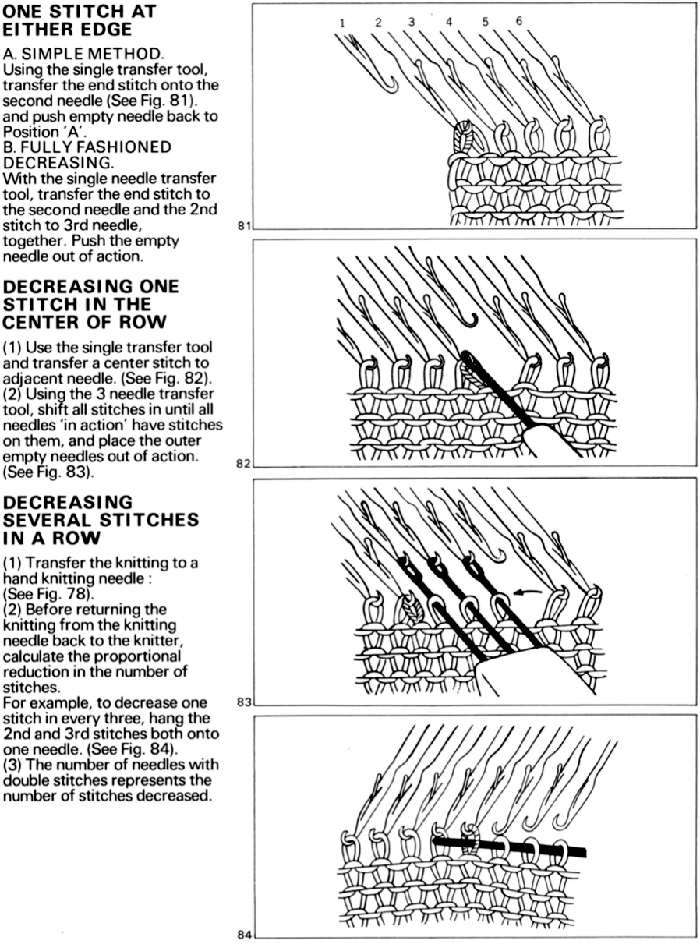 There are wide varieties of stitch holders that may be used to store or move stitches around when tools with enough prongs to serve the purpose are not available, as well as safety-pin-like plastic ones that can hold single open stitches or serve as markers at the edges of the knit.
There are wide varieties of stitch holders that may be used to store or move stitches around when tools with enough prongs to serve the purpose are not available, as well as safety-pin-like plastic ones that can hold single open stitches or serve as markers at the edges of the knit. 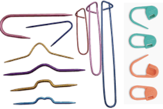 Sometimes appropriate lengths of ravel cord and a yarn needle can serve the purpose as well.
Sometimes appropriate lengths of ravel cord and a yarn needle can serve the purpose as well. 